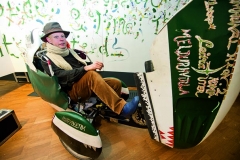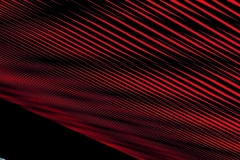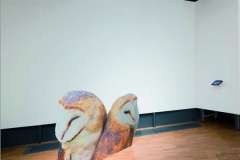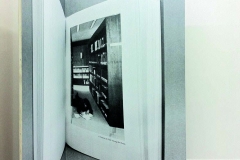You have recently co-edited the comprehensive book Danish Artists’ Books. In your opinion, which historical Danish artists’ books are important and why?
We – the other editors and I – are very happy that Walther König wanted to collaborate with us and publish the Danish Artists’ Books internationally, so it can be found in London, Paris, Berlin and Copenhagen among other cities. It is very difficult to point out particular books: some are classics as pioneer artists’ books, and some I just happen to like. Personally, I am very fond of white books: books that appear to have only white pages, such as some of the earliest examples of artists’ books by K J Almquist and by the Danish author Hans Jørgen Nielsen.
What brought you to artists’ books and publications in the first place?
I am very fond of books. That is a romance that goes back to my early youth. I first started to work professionally and get acquainted with the artists’ books scene when I worked for Jacob Fabricius and his Pork Salad Press. We attended the New York Art Book Fair in 2007, and I experienced a passion for very obscure, small, strange or even very plain books and publications made by artists. In 2010 I worked at Overgaden, the Institute of Contemporary Art in Copenhagen, and I was in charge of their annual Art Book Fair. I decided to extend the concept and invite some of the international art book publishers that I had met in New York and Berlin, and we created the concept Art + Text, which also included exhibitions with artists’ books. Out of this event grew the idea of making a book about Danish artists’ books, covering the history from the earliest attempts in the ‘30s to the very experimental and paradigmatic period of the 60s and all the way to our present contemporary new materialism.
This spring you curated the 16th Tallinn Print Triennial Literacy–Illiteracy. How did you find working with such a traditional and historical format as the triennial for graphic arts in the “post-medium” condition?
That was a challenge! And I loved it. I got the chance to look into the archive of a great tradition, and of course show some new approaches that prove that printed matter is still a very lively art form. As a matter of fact, we now have a situation where the internet is such a dominant feature for all of us that some kind of backlash to materiality seems a necessity. We need something to hold on to, a book for example. It might sound reactionary, but in my opinion it is quite the opposite.
Which works were the key works for you in the exhibition?
It was above all essential to have a triennial that wasn’t too divided between the curated part and the open-call part, and in which a sense of coherence and connectedness was evident. I also liked including a young artist from Estonia, Katja Novitskova, who is having an international career living abroad, and who made a new work for the triennial that sums up some of the current strategies in the young contemporary art scene, her mix of the life of the internet era with some profound thoughts and original ways of printmaking, as in her iPad installation and big printed aluminium owls.
In your introductory text for the catalogue of Literacy–Illiteracy, you quote Goodiepal: “I argue that when we got the Internet we had this notion that NOW we’d get every facet of the truth, but in fact we just all get the same information – all of us. It erodes our imagination. I am sick of that whole thing where texts are simply being copied off the Internet. It is a huge problem. New knowledge must be generated; otherwise the thing has no legitimacy. There has to be some sort of revolt.” In which ways can this new knowledge be generated and what kind of revolt do you imagine?
Goodiepal himself serves as a great metaphor – as an artist, composer and human being – for this revolt. In his opinion, we should allow things to go slower again, as he wrote in a wall text at the Kumu Art Museum: “The further a message has to travel through time and space, the more importance you can add to its content.”
You see a lot of artists working from the same source, Wikipedia, and making works from and about this now accessible knowledge, often about more obscure or scientific matters, such as occult themes and the mysteries of quantum physics. Some works are very interesting, and really succeed in generating new experiences of that knowledge; others, and this is where the approach fails completely, only use it to legitimise an art project that is nothing more than a poor reflection of some truly inaccessible and mysterious phenomenon. In other words, don’t just copy-paste: do something with the stuff!
As I wasn’t in Tallinn when Goodiepal performed, I am very curious about his performance. What was it about?
The performance was an extension of his trip to Tallinn made by bike from Copenhagen through Sweden (it was in February, so of course it was very cold). In the performance he nagged about contemporary artists flying cheaply on Ryan Air to whatever destination. In his view, contemporary hacking should not be done through the internet, but by writing letters. Or by going for a walk – or on a bicycle trip to Siberia – instead of repeating a hasty pattern, with no subversive strategies. If we want to be ahead of our times, we need to slow down.
Can you briefly introduce the topics and speakers of the seminar. Where did the discussion start and where did it end?
We had four speakers: three from the Baltic countries – Maija Rudovska (Latvia), Valentinas Klimasauskas (Lithuania) and Oliver Laas (Estonia) – and the curator of the 30th Biennial of Graphic Arts in Ljubljana, Deborah Cullen (USA), who presented a very interesting paper called Analogue to Digital: Observations of Continuity and Transformation. We discussed whether a triennial of graphic arts was still relevant today, and how we could still develop the media in this modern digital world.
Digital language is dominated by images rather than text. Is our need for the visual constructed or rooted somewhere deeper? You mention in your text that reading became widespread only 500 years ago and our brains do not have a special neural basis for reading texts.
Hmmm, I’m not sure how to answer this, but I know that a lot of people actually write and read much more than they would have without the internet. It is not a secret that literature, newspapers and texts are often written and read by more educated persons, and this is somehow changing with the internet.
Do you think the next generation of artists, who have been using smart phones and iPads since they were toddlers will only use the internet as a primary source of inspiration and information, or will the new materiality and the longing for different and slower ways to work just get stronger over time?
I think these two “tendencies” will continue to grow: the two need each other.
I see the current longing for materials – and for more slow-paced working methods – as a very intelligent way to deal with the hasty production life of late capitalism. It is of course a reaction to the ever-present digital screen life – and a world surrounded by satellites bombarding us with information and binary codes – that we need something very grounded, heavy and slow in order not to lose ourselves completely. But it is also something that comes out of the financial crisis; before the crisis, a lot of artists had veritable factories with assistants that made their artworks in a hardcore production setting, where as now you see more artists working more slowly and being more integrated with their works.
As a curator and art critic, I assume your work also involves a lot of work in front of the screen; for example, we are doing this interview by e-mail, with me typing my questions and you typing your answers. How do you think our conversation would have been different if it was spoken?
The oral situation is of course very different from the written one: that hasn’t changed. The construction of sentences and utterances is much more controlled and hence edited in the written version but, of course, the online reality also allows for Skype meetings and chat interviews. They are just new formats that expand our communication.
What is your personal relationship with the screen? Are you a compulsive participant in the internet culture? How do you personally discipline yourself and control the time you spend in front of the screen?
I spend many hours on my computer. And I watch a lot of shows online. That said, I enjoy being offline a lot, and I know that a lot of people (myself included) are so internet- and facebook-addicted that we really need to set limits and strictly discipline ourselves in terms of engaging with the always present reality presented online. One of the most challenging things for a lot of people today is simply to stay offline for a whole day.
The 16th Tallinn Print Triennial Literacy–Illiteracy is the second time you have worked with the Kumu Art Museum in Estonia. How do you see the Estonian art scene in comparison with the scene in Denmark?
This is a difficult question for me to answer. One very big difference is the lack of commercial galleries in Tallinn. This makes the scene very different from the one in Copenhagen. On the other hand, I’ve met and seen the work of so many interesting and great Estonian artists, and I will continue to work with some of them. Coming up next is a show with Raul Meel in Copenhagen next year.
Maria Kjær themsen (1978), holds an MA in Comparative Literature, and works as an independent art critic, curator and editor. Author of numerous articles, texts and essays about art. Regular contributor to Politiken, Kunstkritikk.dk and Artforum.com. Chief curator of the 16th Tallinn Print Triennial. Lives and works in Copenhagen. See more at: www.mariakjaerthemsen.com
Tallinn Print Triennial,
see more at: www.triennial.ee







